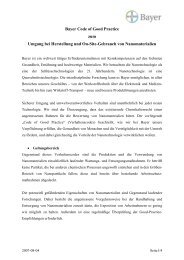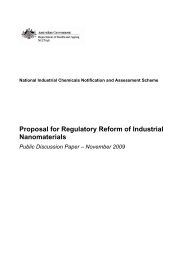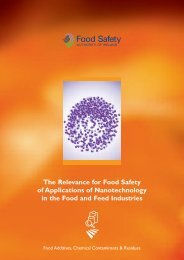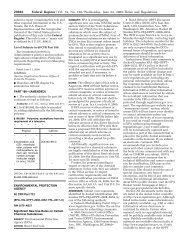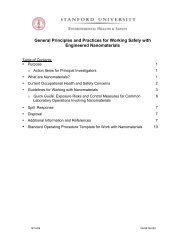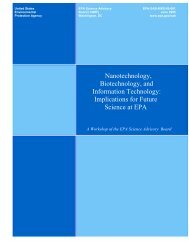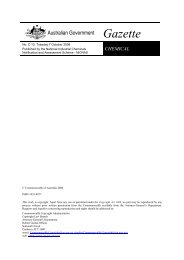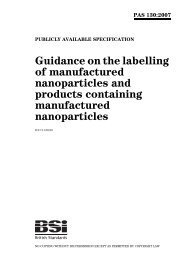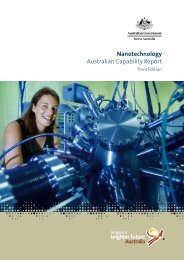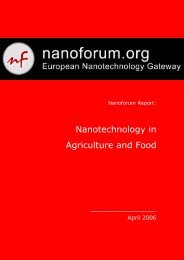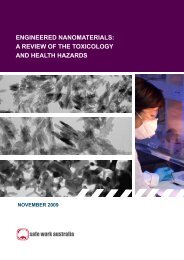Regulation (EC) No 1223/2009 of the European ... - Mattilsynet
Regulation (EC) No 1223/2009 of the European ... - Mattilsynet
Regulation (EC) No 1223/2009 of the European ... - Mattilsynet
You also want an ePaper? Increase the reach of your titles
YUMPU automatically turns print PDFs into web optimized ePapers that Google loves.
22.12.<strong>2009</strong>ENOfficial Journal <strong>of</strong> <strong>the</strong> <strong>European</strong> Union L 342/61(27) To avoid ambiguities, it should be clarified that <strong>the</strong> list <strong>of</strong>allowed colorants contained in Annex IV includes onlysubstances which colour through absorption and reflectionand not substances which colour through photoluminescence,interference, or chemical reaction.(28) To address safety concerns raised, Annex IV, which is currentlyrestricted to skin colorants, should also include haircolorants once <strong>the</strong> risk assessment <strong>of</strong> <strong>the</strong>se substances by<strong>the</strong> Scientific Committee for Consumer Safety (SCCS) setup by Commission Decision 2008/721/<strong>EC</strong> <strong>of</strong> 5 September2008 setting up an advisory structure <strong>of</strong> ScientificCommittees and experts in <strong>the</strong> field <strong>of</strong> consumer safety,public health and <strong>the</strong> environment ( 1 ) has been finalised.To this end, <strong>the</strong> Commission should have <strong>the</strong> possibility toinclude hair colorants in <strong>the</strong> scope <strong>of</strong> that Annex by <strong>the</strong>comitology procedure.(29) The use <strong>of</strong> nanomaterials in cosmetic products mayincrease with <strong>the</strong> fur<strong>the</strong>r development <strong>of</strong> technology. Inorder to ensure a high level <strong>of</strong> consumer protection, freemovement <strong>of</strong> goods and legal certainty for manufacturers,it is necessary to develop a uniform definition for nanomaterialsat international level. The Community shouldendeavour to reach an agreement on a definition in appropriateinternational fora. Should such an agreement bereached, <strong>the</strong> definition <strong>of</strong> nanomaterials in this <strong>Regulation</strong>should be adapted accordingly.(30) At present, <strong>the</strong>re is inadequate information on <strong>the</strong> risksassociated with nanomaterials. In order to better assess<strong>the</strong>ir safety <strong>the</strong> SCCS should provide guidance in cooperationwith relevant bodies on test methodologies which takeinto account specific characteristics <strong>of</strong> nanomaterials.(31) The Commission should regularly review <strong>the</strong> provisions onnanomaterials in <strong>the</strong> light <strong>of</strong> scientific progress.as CMR 1A or 1B substances, <strong>the</strong>re should be a possibility,in <strong>the</strong> exceptional case that <strong>the</strong>se substances comply withfood safety requirements, inter alia as a result <strong>of</strong> <strong>the</strong>ir naturallyoccurring in food, and that no suitable alternativesubstances exist, to use such substances in cosmetic productson <strong>the</strong> condition that such use has been found safe by<strong>the</strong> SCCS. Where such conditions are met, <strong>the</strong> Commissionshould amend <strong>the</strong> relevant Annexes to this <strong>Regulation</strong>within 15 months <strong>of</strong> classification <strong>of</strong> substances as CMR1A or 1B substances under <strong>Regulation</strong> (<strong>EC</strong>) <strong>No</strong> 1272/2008.Such substances should be continuously reviewed by <strong>the</strong>SCCS.(33) A safety assessment <strong>of</strong> substances, particularly those classifiedas CMR 1A or 1B substances, should consider <strong>the</strong>overall exposure to such substances stemming from allsources. At <strong>the</strong> same time, for those involved in producingsafety assessments, it is essential that <strong>the</strong>re be a harmonisedapproach to <strong>the</strong> development and use <strong>of</strong> such overallexposure estimates. In consequence, <strong>the</strong> Commission, inclose cooperation with <strong>the</strong> SCCS, <strong>the</strong> <strong>European</strong> ChemicalsAgency (<strong>EC</strong>HA), <strong>the</strong> <strong>European</strong> Food Safety Authority(EFSA) and o<strong>the</strong>r relevant stakeholders, should, as a matter<strong>of</strong> urgency, carry out a review and develop guidanceregarding <strong>the</strong> production and use <strong>of</strong> overall exposure estimatesfor <strong>the</strong>se substances.(34) The assessment by <strong>the</strong> SCCS <strong>of</strong> <strong>the</strong> use <strong>of</strong> substances classifiedas CMR 1A and 1B in cosmetic products should alsotake into account <strong>the</strong> exposure to those substances <strong>of</strong> vulnerablepopulation groups, such as children under threeyears <strong>of</strong> age, elderly people, pregnant and breast-feedingwomen and persons with compromised immuneresponses.(35) The SCCS should give opinions where appropriate on <strong>the</strong>safety <strong>of</strong> use <strong>of</strong> nanomaterials in cosmetic products. Theseopinions should be based on full information being madeavailable by <strong>the</strong> responsible person.(32) Given <strong>the</strong> hazardous properties <strong>of</strong> substances classified ascarcinogenic, mutagenic or toxic for reproduction (CMR),category 1A, 1B and 2, pursuant to <strong>Regulation</strong> (<strong>EC</strong>)<strong>No</strong> 1272/2008 <strong>of</strong> <strong>the</strong> <strong>European</strong> Parliament and <strong>of</strong> <strong>the</strong>Council <strong>of</strong> 16 December 2008 on classification, labellingand packaging <strong>of</strong> substances and mixtures ( 2 ), <strong>the</strong>ir use incosmetic products should be prohibited. However, as ahazardous property <strong>of</strong> a substance does not necessarilyalways entail a risk, <strong>the</strong>re should be a possibility to allow<strong>the</strong> use <strong>of</strong> substances classified as CMR 2 substances where,in view <strong>of</strong> exposure and concentration, <strong>the</strong>y have beenfound safe for use in cosmetic products by <strong>the</strong> SCCS andare regulated by <strong>the</strong> Commission in <strong>the</strong> Annexes to this<strong>Regulation</strong>. With regard to substances which are classified( 1 ) OJ L 241, 10.9.2008, p. 21.( 2 ) OJ L 353, 31.12.2008, p. 1.(36) Action by <strong>the</strong> Commission and Member States relating to<strong>the</strong> protection <strong>of</strong> human health should be based on <strong>the</strong>precautionary principle.(37) In order to ensure product safety, prohibited substancesshould be acceptable at trace levels only if <strong>the</strong>y are technologicallyinevitable with correct manufacturing processesand provided that <strong>the</strong> product is safe.(38) The Protocol on protection and welfare <strong>of</strong> animals annexedto <strong>the</strong> Treaty provides that <strong>the</strong> Community and <strong>the</strong> MemberStates are to pay full regard to <strong>the</strong> welfare requirements<strong>of</strong> animals in <strong>the</strong> implementation <strong>of</strong> Community policies,in particular with regard to <strong>the</strong> internal market.



